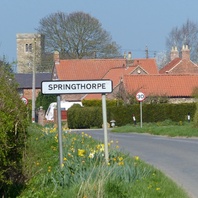
Viking Names
Springthorpe
Springthorpe, in the Corringham Wapentake of Lincolnshire, is an Anglo-Scandinavian compound from Old English spring ‘a spring, a well, the source of a stream’ and Old Norse þorp ‘a secondary settlement, a dependent outlying farmstead or hamlet’.
Read More
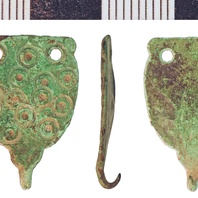
Viking Objects
Hooked Tag (NLM-8E96D5)
This example of an Anglo-Scandinavian copper-alloy hooked tag is classed as a Read Class A Type 1 or Class B Type 1. The tag is decorated with a stamped ring-and-dot motif which was a popular style among Scandinavians.
Read More
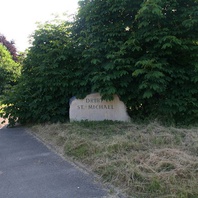
Viking Names
Driby
Driby, in the East Lindsey district of Lincolnshire, is an Anglo-Scandinavian hybrid name from Old English dryge ‘dry, dried up’ and Old Norse bý ‘a farmstead, village’.
Read More

Viking Names
Flixborough
Flixborough, in the West Riding of Lindsey in Lincolnshire, is a hybrid name from the Old Norse male name Flík and Old English burh ‘a fortified place’. It is highly likely, in a place-name with Old English burh as the second element, that the Old Norse Flík has replaced an earlier Old English name or element. An important Anglo-Saxon settlement site has been excavated here.
Read More
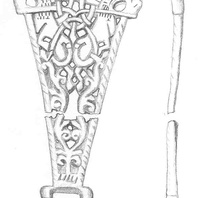
Viking Objects
Harness Fitting (NLM168)
This harness fitting, now broken into two parts, is trapezoidal in shape with two strap loops and is decorated with elaborate interlace decoration. The main element consists of two adorsed animals, possibly horses, set within a field of plant interlace.
Read More
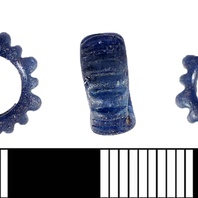
Viking Objects
Glass Bead (PUBLIC-170BD9)
This monochrome glass bead is blue coloured and has a decorative edging in a reed like pattern. Similar beads have been found in other Anglo-Scandinavian contexts. Glass beads were, generally, used in necklaces or similar jewellery and were highly prized among Scandinavians.
Read More
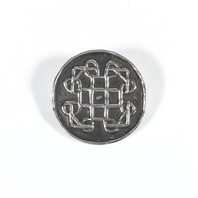
Viking Objects
Reproduction Terslev Brooch
This Borre-style brooch has been identified by Jane Kershaw as a Terslev Type V variant. Terslev style, where Scandinavian ring-chain patterns are the main decorative component, is a subcategory of the Borre style and takes its name from the silver hoard discovered in Terslev, Denmark. The decoration comprises a series of ring-knots related to the Borre ring-chain. The Terslev style occurs mainly on brooches and pendants, including both high-quality gold and silver jewellery as well as lower-end base-metal items. The cast base-metal ornaments, such as those made of copper alloy, were intended to imitate the higher-end gold and silver jewellery, and often employed techniques such as gilding to achieve this. The Terslev designs that occur in England extend the repertoire by introducing new Scandinavian motifs hitherto unrecorded in Scandinavia. For more information on Scandinavian jewellery in England check out our blog: Brooches, Pendants and Pins: Scandinavian Dress Accessories in England.
Read More
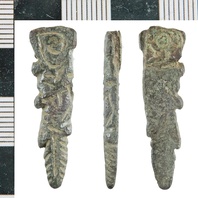
Viking Objects
Strap-End (NLM-42CC0B)
This copper-alloy strap-end is classified as a Thomas Class G type with Viking attributes. The decoration consists of large bordered eye-shaped interlace which may possibly resemble the Urnes style. Strap ends came in various styles and were fairly common throughout the Viking world. They were used to decorate the ends of belts and to stop them getting damaged.
Read More
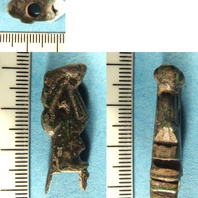
Viking Objects
Prick Spur (LIN-646C93)
Early spurs had a neck that ended in a point, called a prick, riveted to the heel band. This object is a fragment of the prick and is cylindrical in section with a terminal that divides into two arms. There is a hollow shaft above leading into two decorative crescent-shaped arms, one arching over the other. The very top of the object is pierced which suggests that something passed through the object.
Read More
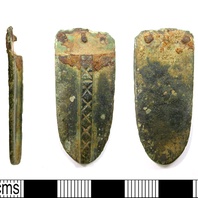
Viking Objects
Copper-Alloy Strap-End (LEIC-07ED69)
This tongue-shaped strap-end, classed as Thomas Class E Type 3, is decorated with a rectangular cross-sectioned vertical ridge running down its centre with incised ‘saltaire’ crosses.
Read More
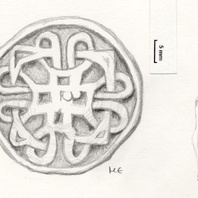
Viking Objects
Lead-Alloy Terslev Brooch (NLM-72D1C7)
This Borre-style brooch has been identified by Jane Kershaw as a Terslev Type V variant. Terslev style, where Scandinavian ring-chain patterns are the main decorative component, is a subcategory of the Borre style and takes its name from the silver hoard discovered in Terslev, Denmark. The decoration comprises a series of ring-knots related to the Borre ring-chain. The Terslev style occurs mainly on brooches and pendants, including both high-quality gold and silver jewellery as well as lower-end base metal items. The cast-base metal jewellery, such as those made of copper alloy, were intended to imitate the higher-end gold and silver jewellery, and often employed techniques such as gilding to achieve this. The Terslev designs that occur in England extend the repertoire by introducing new Scandinavian motifs hereto unrecorded in Scandinavia. For more information on Scandinavian jewellery in England check out our blog: Brooches, Pendants and Pins: Scandinavian Dress Accessories in England.
